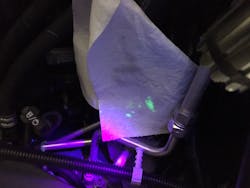Which tool to use for leak detection
Tools Used:
· Vehicle Service Information
· Leak Detection Dye
· Diagnostic Smoke Machine
· Electronic Leak Detector
Vehicles affected: All
Leaks from a vehicle can appear in many forms and can come from many sources. The tools used to locate them vary as well, some working very well for one type of leak and not working well at all for another.
In this tool comparison, we will look at different types of leaks and discuss what leak detection tool will work best for each.
Vehicle Service Information
It is sometimes difficult to remember that leaks may not be unique to the vehicle you are working on. They might share something in common with other vehicles of the same type or vintage. If you keep this in mind, one of the best - and maybe easiest - places to start looking for the cause of a leak is inside your vehicle information database.
For example, we had a client who was concerned about a small amount of grease leaking from the electronic power steering motor housing on their 2013 Chevrolet Silverado. We looked at the housing and confirmed some grease was present, then checked the torque to make sure there were no loose bolts. When looking up the torque specification in Mitchell 1 ProDemand, we checked for technical service bulletins (TSBs) and found one that addressed a slight leakage at the same area where this Silverado was leaking. Using the TSB as a guide, we determined the leak was nothing to be concerned with. We then cleaned the area and advised and shared the service bulletin with our client.
Another recent example was a 2014 Honda Odyssey that had oil leaking from the main bearing cap bolts on the side of the block. Mitchell 1 ProDemand came through again with a TSB that indicated that, instead of performing a costly repair of dismantling the entire engine, it would be possible to remove the bolts, clean them, then reinstall and torque them – adding a sealant from Honda.
Lesson learned: Check for TSBs before you spend what can be significant time diagnosing leaks; determining how a leak may be repaired can be extremely valuable.
Here is a list of a few different leak detection tools, and the properties that may be beneficial in various diagnostic situations.
1. Leak detection dyes
The difficulty in locating fluid leaks is this: the location where you see the fluid is most likely not the origination point of the leak, but a spot where the fluid has transferred to. In most cases, using leak detection dyes is the best method to locate the origination of a fluid leak because they will highlight the trail of fluid so it can be tracked back to its origin. Fluorescent dyes are then added to the fluid, depending on the dye used, and a UV or a blue light illuminates the suspected areas of the leak. Any trace of the dye will fluoresce when the proper light is used.
Some of the facts you must remember: there is no such thing as a universal leak dye, nor is there a universal light to fluoresce the dyes. Additionally, specific dyes may for used with oil-based fluids (engine oil, transmission and power steering fluids, and fuels) and others will work with most coolants.
One of the most popular uses of dyes is in air conditioning systems to determine where small leaks are located. Using dye in air conditioning systems creates unique challenges because A/C dyes are suspended in refrigerant oil, and different oils are used for different refrigerants, requiring a different dye for each type of oil (PAG, Esther, etc.). The other challenge with A/C dyes is that most late model vehicles have very small tolerances for oil and refrigerant charge capacities, so it is possible to add too much dye (oil).
After dyes are installed, the engine or system must be run to distribute the dye throughout the system. This can take anywhere from a few minutes to a half hour. If the leak is small or intermittent, the vehicle may need to be driven for a period of time then returned for inspection with the UV or blue light.
Out-of-the-box thinking for leak detection dyes:
· Add dye to the fuel filter on diesel engines to locate fuel leaks at injectors, cylinder heads or connection tubes.
· Allow the A/C evaporator to frost up, then let the evaporator defrost, causing drips from the evaporator box drain. Use fluorescent light on the pool of water. Drain tube to check for leaks.
· Slide a towel along the bottom of components, then look for traces of dye on the towel.
2. Diagnostic smoke machine
Many technicians still think the only use for a smoke machine is to test EVAP systems or look for vacuum leaks. Granted, they are extremely useful for both of these tasks, diagnostic smoke machines can be used to find many other types of leaks, too.
Consider using a smoke machine to locate fluid leaks. If you connect the smoke tester to a vent hose of a transmission or transaxle and apply low pressure, any leaks will be quickly found. This can be very helpful for locating leaks in a porous casting.
Another great use of smoke testing is to locate water or air leaks around the dash, windows or door seals. No, do not fill the car with smoke. Close all the doors and windows, then turn on the vehicle's A/C blower on high in recirculate mode. This will create a positive pressure within the vehicle. Move the stream of smoke from your tool along door and window seals, and under the hood along the firewall. Any leaks will cause the stream of smoke to move away from the vehicle.
High pressure smoke test equipment is required to test for leaks in large volume systems, such as large exhaust systems or large air charge coolers. With the advent of more turbocharged vehicles, a high-pressure tester is now necessary to test for intake or exhaust leaks, which can drastically affect performance. Additionally, even the smallest exhaust leak can cause the engine management system to malfunction. False catalytic converter fault codes can easily be caused by exhaust leaks that cannot be heard, but can be located with a high-pressure smoke machine.
Out of the box thinking for smoke machines:
· Use the smoke tester in a dipstick tube to check for crankcase leaks. Even the smallest crankcase leak can affect the ability of the PCV system to maintain the proper pressure in the crankcase, which can cause leaks.
· Using a laser pointer along vacuum lines may allow you to see a smoke trail more easily.
· Connect your smoke machine to air shock or air strut tubing to find leaks.
3. Electronic leak detectors
Electronic leak detectors have been around for many years. They are mostly used for air conditioning system leak detection. Early versions of electronic detectors were not able to locate small leaks and were susceptible to malfunctions caused by contamination of fluids and even air movement. The newest requirement for electronic A/C leak detectors is they must be able to detect leaks as small as 0.25 oz. per year.
Technicians are also required to use electronic lead detectors with R1234yf, which is slightly flammable. If you are currently using an older electronic detector, it should be upgraded to a newer version compatible with the latest regulations.
When using any detection method for locating A/C system leaks, remember that oil will usually leak along with the refrigerant. Since oil is heavier than air, look on the under-side of tubing, compressors and other components for leaks. When using an electronic detector, make sure the system has a sufficient charge, then turn the engine off. This does two things: it stops air movement under the hood and equalizes pressures on both the high and low sides of the system.
Ultrasonic leak detectors can be used to locate even the smallest leaks. These testers locate leaks by detecting ultrasonic sound generated by escaping air. For example, to test an A/C system, pressurize the system by using an inert gas (nitrogen), then use the tool to listen for the noise. Once you find the general area, fine tune the tool to pinpoint the leak. The benefit of ultrasonic testers is they are not reliant on a refrigerant charge to locate a leak, and they can be used even if there is a lot of ambient noise in the shop.
Conclusion
To sum it up, there are just as many technologies for locating leaks as there are types of leaks. One type of tool will not work for all applications, so you will most likely need to invest in many different tools. Don’t be afraid to try your leak detection tool in a unique way to see if it will work to find leaks it may not have been designed to locate.
About the Author

Barry Hoyland
Barry Hoyland has been in the independent aftermarket for more than 45 years as a technician, technician instructor, shop owner, and shop management consultant. He owned and operated a successful Southern California automotive repair center that offers complete auto care and specialized in emission and diagnostic services for over 28 years. Hoyland also owned a company that modified vehicles to perform as emergency response units and mobile command centers, incorporating high-end electronic components into today’s vehicles. Hoyland has experience with all size and types of vehicles including traditional gas, hybrid electric, alternative fuel, and heavy duty diesel trucks.
Hoyland has provided consulting services for many automotive shops, fleets, and government agencies in order to improve their operational efficiencies.
In addition, he has worked with many NHRA drag racing teams as a crew chief on supercharged alcohol and nitro-methane fueled cars and currently serves as a crew chief on a Top Alcohol Funny Car, a Nostalgia Funny Car, and a Nostalgia Alcohol Dragster
Hoyland holds certifications in ASE: A1, A6, A8, and L1, MACS 609, maintains a California Advanced Emission license, and a CDL with endorsements for double and triple trailers, tankers, and HazMat.
When he is not helping to run a shop in the Pacific Northwest, Hoyland travels across the U.S. as an instructor of technical and shop management courses, many of which he has developed.
